CAMDEN, NEW JERSEY
![]()
CHURCH OF THE
SACRED HEART
Southwest corner of Broadway &
Ferry Avenue
![]()
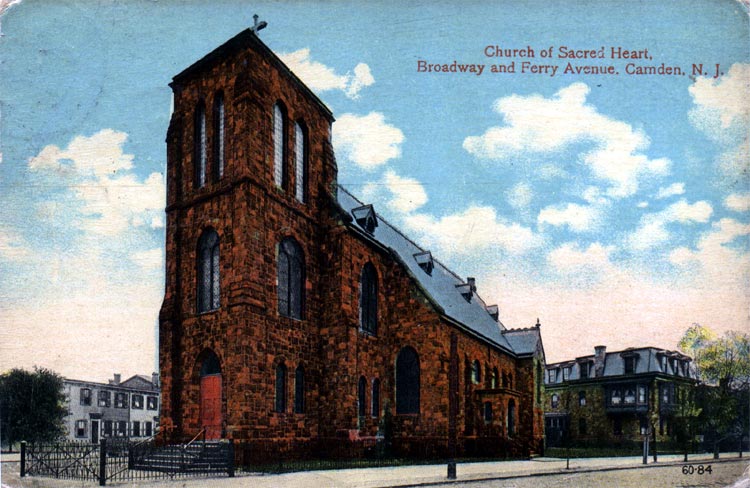
|
![]()
|
The
following is derived in part from |
|
The first Roman Catholic Church to be built in Camden was St. Mary of the Immaculate Conception in Camden, which was opened in. Camden was growing quite rapidly, and its first church, St. Mary's, built by the pastor James Moran, soon proved to be too small. In 1864 the second pastor, Patrick Byrne, started a new church of the Immaculate Conception at Broadway & Market Street , and in 1867 a new church opened up, Ss. Peter and Paul, in 1867. Further growth spurred Father Byrne into establishing a mission in South Camden. Father Byrne bought a plot of land at Eighth and Van Hook Streets. There, in 1872, a little wooden building was erected. The Bishop of Newark sent down Dean William McNulty of Paterson to bless it. The people gathered, the Mass was offered, the sanctuary lamp was lit, and the Church of The Sacred Heart came to life in Camden. In 1885 a separate parish was formed and Right Rev. M. J. O'Farrell appointed Rev. William Lynch rector. |
|
||||
|
Philip McDonald, Master Mason Builder of Sacred Heart
Church
He
took a heap
of broken stones
|
|
||
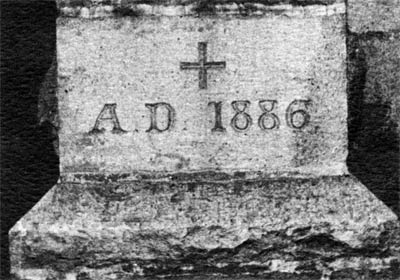
|
|
||||||||||||||||||||||||||||||||||||||||||||||||||||||||||||||||||||||||||||||||||||||||||||||||||||||||||||
|
The Irish Connections of Sacred Heart When Kathleen O'Toole and Kathleen Mauger, parishioners of Sacred Heart, poured Easter water from their century-old church in Camden, New Jersey, on a big flat rock in Downpatrick County Down on July 18, 1985, they were celebrating a continuous connection between their beloved brownstone building in Camden and the precious dust of a saint in Ireland - St. Patrick himself! Not just a connection between rocks and buildings or bodies and bones and blood, but the unbreakable bond of an enduring Irish spirit. They were celebrating the centennial of their church by concentrating on that connection. When they lit the candle they had carried from Camden, their tiny flame was a spark that had held Since Patrick's fire on Slane. Held out in high and icy wind since the Fifth Century, when he lit new flames on Easter Eve before the angry Druids lit old ones in Tara, County Meath. Whether he admitted it or not, Patrick built his fire on the coals that Druid hands had raked in the ancient ashes of Ireland. Since then, for 1,500 years, bright sparks have flown as shovels hit the stones and broke ground for countless Irish churches across the world. It was the same spark that stirred the people and moved the stones when William Lynch, a young 26-year-old priest put his shovel in the sands of South Camden on May 20, 1886, for the building of Sacred Heart. He had purchased the site at Broadway and Ferry in November of 1885, one month after the parish was incorporated on October 13th. Another Irish parish had started and the people who came to worship had names like Boyle and Doyle, Blake, Doran and O'Toole, Hughes, Larkin and Durkin, and, yet, it would be 90 years before the parish got its first Irish-born pastor, Michael Doyle, on November 11, 1974. Exactly 119 years before, on November 11, 1855, Camden City got its first resident priest, Father James Moran of Roscommon, born there in 1824, related on his mother's side to Daniel O'Connell, the Irish patriot. Fr. Moran broke ground for St. Mary's Church on June 9, 1859. In 1863, he was succeeded by Fr. Patrick Byrne. It was this Irishman, born in Templeport, County Waterford, who established the second Catholic Church in the City of Camden, a little wooden building as a mission in his parish. The year was 1872 and Camden was in the Diocese of Newark, and this little church was the first in New Jersey to be called Sacred Heart. Following Fr. Byrne, it was serviced by Fr. Peter Fitzsimmons who was born near Virginia, County Cavan in 1840 and in his pastorate, Sacred Heart became a parish, and Fr. Lynch came up from Gloucester to run it. He hired Jeremiah O'Rourke, a well-known Newark architect to design it, Philip McDonald to build the walls, and Mayberry Harden of Camden to do the roof, windows and woodwork. Six weeks after breaking ground, the foundation stone was laid on Sunday, July 4, 1886 with a show of green pomp and power that "shouted from the housetops of Camden" that "the faith of our fathers was living still." The winds had carried Patrick's fire to Nova Caesarea (New Jersey) just as surely as when "Jesus came to Caesarea Phillipi," another colony in another time. The Irish came to Camden to build a railroad, the Camden and Amboy Line that linked Philadelphia to New York in 1834 and changed the city in a century from a few mudhole lanes of pigs and people into the most dynamic city of its size in the nation. The population, only 1,100 in 1828 when the city was incorporated, swelled to 75,000 by the end of the century. The "coffin ships" of Ireland's desperate famine dumped some of their tired "huddled masses" in New York and many came down to the end of the line, Camden. In time, they got to their feet with pick or potstick, shovel or washboard and took their place in America. They came together in little clusters of Catholicism to cling to their faith and start a church if they could. They were consistently poor and always powerless, held back, as they were, at the hurting edge of prevailing prejudice. Their church became a haven of respectability, social activity and spiritual support. In and around it, they learned urban survival, urban participation, and ultimately, urban power. Irishmen in thousands had walked with Washington in the war with the British, giving limb and life in a desperate revolution. They had pranced with him on the Union Jack at Mass in Willings Alley in Philadelphia, when the war was won. Indeed, many of the stripes - by the stars in the new flag - are streams of generous Irish blood. So, the Fourth of July 1886 was the day! The faith and the flag and the foundation stone of Sacred Heart! The Bishop of Trenton, Limerick-born Michael Joseph O'Farrell with the crozier, and Lynch of New Brunswick with the trowel, and 7,000 people looking on. The Camden Daily Courier for July 3rd, 1886, headlined the next day's event as, "A cornerstone laying that will attract attention." It did. Three days later, the same paper describes the mighty event: "The cornerstone of the new church of the Sacred Heart, at Broadway and Ferry Avenue, was dedicated with impressive ceremonies, and no such demonstration of a religious character had ever been seen in this city." The newspaper added that the church would cost about $16,000 and would most likely be ready for dedication by Christmas, 1886. It was not ready by Christmas, but it was completed shortly afterwards in what was an extraordinary achievement because from the "breaking of the ground" on May 20, 1886, to the breaking of the bread at the dedication Mass on March 6, 1887, was a period of only nine months. However, the reported estimate of $16,000 turned out to be inaccurate because the actual cost of the church and rectory was more than $35,000. An awesome amount when one considers the total Sunday collection of Fr. Lynch's small congregation was $2.50. Two years after the establishment of this beachhead of Irish Catholicism, Fr. Lynch, broken by the burden of heavy debt, had to be removed from Sacred Heart. The task of carrying on the effort fell on the young priest, Maurice Bric, who became pastor of Sacred Heart for 25 years. For 13 of those years, he went on to the highways and byways, five days a week, collecting pennies and nickels from his poor, scattered parishioners to pay the mortgage on Sacred Heart Church. In 1900, New York Shipyard opened in the shadow of the church and the population increased and the parish prospered. The third pastor, Fr. John McCloskey, burned the mortgage in 1915. He built the school, visited Ireland and gave a parish donation of $1,500 to the Patrick H. Pearse branch of the American Commission for the Relief of Ireland, in 1921. In his words, the donation was "proof of our enthusiasm and willingness to aid our ancestors in the Emerald Isle in their hour of distress." Times have changed in the Sacred Heart section of Camden. The Irish have long since left the flat roof factory homes of South Camden. But over the years the connection with Ireland has not been severed and Irish priests like James Gaffney, Michael Coyne, Donal Sheehan, and sisters such as Patricia Margaret Foley of Kerry, Agnes Holmes of Mayo, and Marie McGloin of Leitrim have done good work in this parish of Sacred Heart. Present parishioners like Linda Delengowski and Dan Dougherty have worked with Paddy Doherty of Derry and his Youth Project in that special city. Good workers in Sacred Heart today are Paddy Mulligan and Rose Knebles, both of Ireland. Sacred Heart in 1985 is made up of a coalition of neighborhood people and those who come from near and far to this old church on the corner of Broadway and Ferry. Because injustice is high in the consciousness of those who come, they are often called to pray and work for the people of South Africa, Central America, the North of Ireland and the South of Camden. The old walls of Sacred Heart have been enhanced by the music of Mick Maloney and Eugene O'Donnel and by the splendid Gaelic singing of Barbara Dever. They have throbbed to the piano playing of James McCafferty of Derry and the golden voice of his daughter, Una. They have braced themselves for the brilliance of a Daniel Berrigan and the eloquence of a John MacNamee, and the charming courage of a Paddy Doherty. But most recently, when Kathleen O'Toole and Kathleen Mauger returned to Sacred Heart with the stump of a Camden candle they had lit on St. Patrick's grave in Downpatrick, the circle of the Irish connection was wonderfully renewed. lt will undoubtably endure like the Celtic crosses of Clonmacnoise, the brave spirit of Camden's poor and the bright flame of Patrick's Easter fire on Slane. |
|
Mary Higgins Hampton
"Mom" was Ruth Oberst's mother, the Florence Nightingale of 8th and Van Hook, and later of 9th and Division Streets: Mary Higgins Hampton. Mary was born on November 1, 1874, All Saints Day, and on that day her mother died. The baby was placed in an orphanage in Philadelphia near Sts. Peter and Paul parish. When Mary was five years old, Mary and John Higgins "found her." The young couple had just lost their own baby girl, also named Mary. They adopted this new little Mary, closed their saloon in Philadelphia, and moved to 8th and Van Hook Streets, Camden, to start a new life in the "country" with their new little girl. John Higgins raised chickens and ducks at 8th and Van Hook. He had a house built right next door to the Sacred Heart mission church. John and little Mary would often take eggs to the orphanage in Philadelphia where they had found her. On one of those excursions when Mary was older, she asked her father if she could adopt a baby sister. So Bessie joined the Higgins family as a sister to Mary, but was later formally adopted by her as a daughter when she married. Those who knew her say patience was one of Mary Higgins' greatest virtues, along with a good sense of humor. Such qualities in young Mary must have caught the eye of Fr. William Lynch, pastor of the Sacred Heart mission church, for when Mary was only 12 years old, and the little church was to close, it was to Mary Higgins that Fr. Lynch gave the old wooden cross for safekeeping. Mary's love and devotion to her friends and family flourished. She became "Miss Mamie" to a grateful neighbor, and the name remained with her. All the neighborhood children whom she nurtured and loved came to call her Aunt Marne. Mary Higgins worked at Croft Mills. She and her friends would often go to the dances at Immaculate Conception. Fr. Maurice Brie, Sacred Heart's second pastor, would be waiting to admonish the girls when they returned home to South Camden! Mary was very friendly with Fr. Bric and he was very good to her. Fr. Bric performed the marriage ceremony of Mary Higgins and John Hampton at Sacred Heart Church in 1900 when Mary was 26 years old. Mary and John raised their family of seven children at 9th and Division Streets. The children, Mary, Merab, John, Joseph, Hannah, Naomi, and Ruth were all baptized by Fr. Bric. When Ruth and Naomi were teenagers, their parents moved the family to Parkside. Mary was dedicated to her family, but she also found time to counselor nurse anyone in need. There was always room for one more. Mary often took in children when their families had troubles, extending to them the love she had for her own. Although they were poor, Mary and John would pack all the children and go off to their "summer home" in Glendora along the Newton Creek. The children would only use the cabin to eat and sleep! After work, John Hampton would join his family via the railroad's "Peanut Line." During the 1918 flu epidemic Mary nursed many sick people in the neighborhood. Miraculously, none of her own family ever came down with the flu. Often former children from the neighborhood would return to visit and thank "Aunt Marne." "Mrs. Hampton gave me good advice," was heard more than once. When Mary Higgins Hampton was about to make her last move - to live with her son John in Haddon Heights - she gave out one more bit of good advice. As she passed the old wooden cross from the mission church of Sacred Heart into the hands of her daughter Ruth, she impressed on her clearly: "Don't ever throw it out." Ruth heeded her mother's words. She carefully kept the cross, and on the night of Holy Thursday, 1983, 96 years after her mother had received it, Ruth passed it on … into the hands of John McGuire, who proudly carried the mission church cross down the aisle of the "new" Sacred Heart Church, only a few years short of its first century.
|
|
|
||||||
|
|||||||||||||
|
||||||
|
||||||||||||
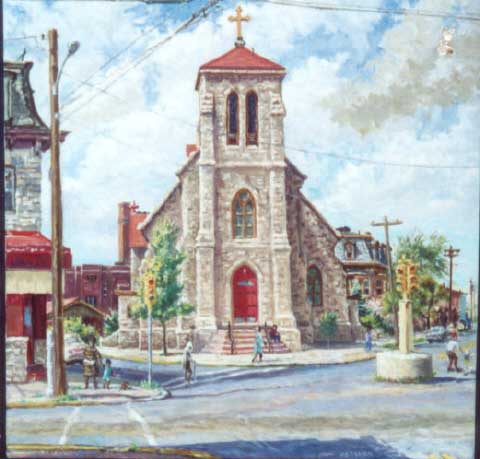
|
![]()
|
Camden Courier-Post - June 2, 1932 |
|
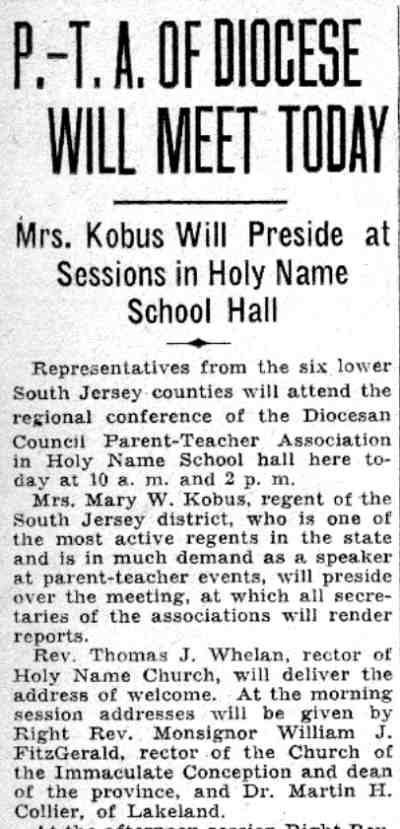
|
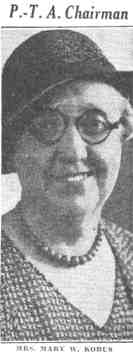
|
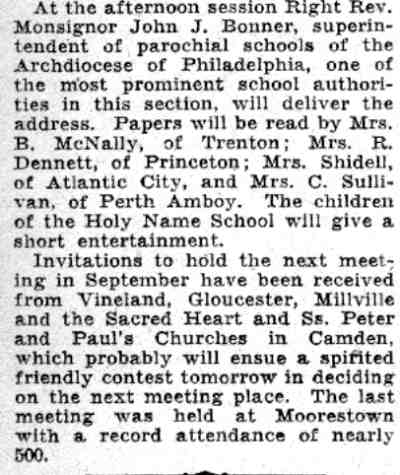
|
|
|
Mary
W. Kobus
- Holy
Name Roman Catholic Church
- Church
of the Sacred Heart Ss. Peter and Paul's Roman Catholic Church - Church of the Immaculate Conception |
|
| Camden Courier-Post * June 8, 1932 |
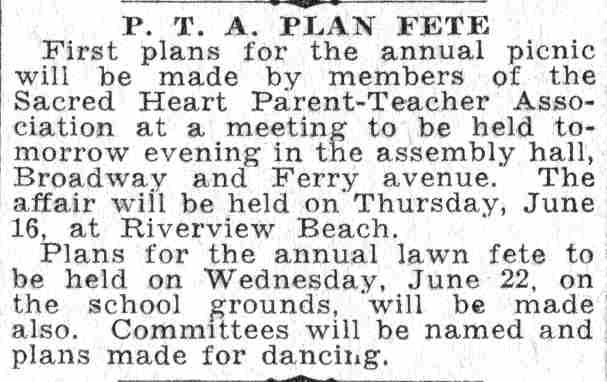
|
| Camden Courier-Post * June 8, 1932 |
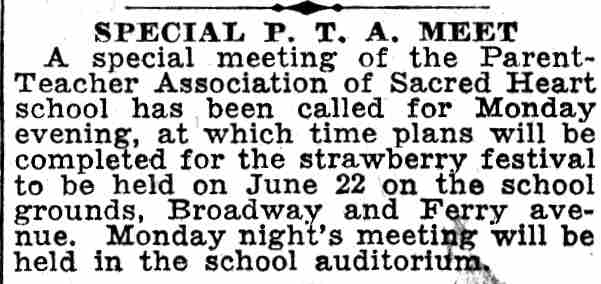
|
![]()
| Camden Courier-Post * June 16, 1933 |
|
GRADUATION SUNDAY AT SACRED
HEART Sacred Heart parochial school, Broadway and ferry avenue , will hold commencement exercises Sunday night at the Sacred Heart Church. Prizes donated by the Parent-Teacher Association will be given to honor students. Communion breakfast will be served to graduates after the 9 o'clock mass Sunday morning, with the Rev. Peter Kelly. The graduates: George Anderson, John Bittman, Elbert Butler, Claire Cline, Mildred Cole, Thomas Cole, Catherine Conlin, Mary Corbett, Evelyn Costello, Mary Daley, Antionette Di Camillo, Herman Di Camillo, Mary Degemis, Alice Fiedler, Daniel Fitzpatrick, Eleanor Francy. Joseph Gavrantck, Irene Hancharuk, Anna Harmick, William Higgins, Catherine Hubert, Margaret Huntley, James Jacob, Marcella Koch, Helen Kowchik, Elizabeth Kush. Anthony Leszczkowskl, Ella Levins, Marie Mazur, John McAnany, Mary McNamara, James McNamara, Daniel McNutt, Magdelena Meade, John Mihaich, Eleanor Moser, Helen O'Connell, Rita Reuling, Stephan Rubino, Louise Russian. Clara Sadowski, Anthony Scarduzio, Agnes Scholtz, Colette Smith, Margaret Smith, John Waterhouse, Charles Waters, Rosalie Weiss and Veronica Washnak. In the commercial class are Anna Anderson, Mary Conner, Mary Gettinger, Mary Harmick, Anna Lanni, Anna Salkauski, Elizabeth Schmitt, Barbara Sienski, Francis Visgil and Elizabeth Beck. |
| Camden Courier-Post * June 19, 1933 |
|
Parochial School at Ferry Avenue and Broadway Has Commencement A class of 59 students, 49 in the eighth grade and ten in the commercial department, were graduated last night from Sacred Heart Parochial School at commencement exercises at the parish house, Broadway and ferry avenue .
A communion breakfast was served the class after the 9
o'clock mass yesterday morning. The address to the graduates was made by Rev. Joseph
Sutliff, of Runnemede. Others participating in the commencement program were Rev.
Peter J. Kelley,
rector, Prize winners follow:
Elizabeth,
Zeck, for general excellence in commercial class, donated by Father Kelley; Stephen
Rubino and Mary
Daley,
for general excellence in the eighth grade, donated by Father Kelley; John
Waterhouse and Agnes
Scholtz, for application
in eighth grade, donated by Parent-Teacher Association; Elbert Butler and Ella
Levins, for Christian
doctrine in eighth
grade, donated by Mrs. Jules Thebaud: Margaret Huntley, for English in eighth grade,
donated by Mrs.
Charles Wade.
Other prizes for general excellence, donated by Father Kelley, were won by Francis
Hoffnauer, Mary
Alice Herman, Rita |
| Camden Courier-Post * June 26, 1933 |
|
FINAL P.-T. A. MEET The closing meeting of the Parent--Teacher Association of Sacred Heart School will be held in the assembly hall, broadway and ferry avenue , to morrow evening. Mrs. Frank Kelley, president, will be in the chair. Final plans will be made for a cake sale to be held Saturday afternoon and evening at 1809 broadway . |
| Excerpted
from the Camden Courier-Post * June 1, 1939 |
||||||||||||||||||||||||||||||||||||||||||||||||||||||||||||||||||||||||||||||||||||||||||||||||||||||||||||||||||||||||||||||||||||||||||||||||||||||||||||||||||||||||||||||||||||||||||||||||||||||||||||||||||||||||||||||||||||||||||||||||||||||||||||||||||||||||||||||||||||||||||||||||||||||||||||||||||||||||||||||||||||||||||||||||||||||||
|
Campbell's
Soup Wins Slugfest from 12th Ward, 12 to 8
Outslugging Twelfth Ward, Campbell's Soup went into a tie for first place in the American Division of the Kobus Twilight League when it defeated the "Warders" 12 to 8 at Dudley Grange Park in one of four games played last night. In another American Division tussle, St. Joseph's Polish soundly trounced the Polish American Citizens Club, 13 to 1 at Broadway and Everett street. In a pair of National Division tussles, the Walker Robins gained a firmer grip on second place when it whipped Sacred Heart at the Fairview Ball Park, 13 to 1 and Lincoln took the measure of St. Joan of Arc at Seventh and Jefferson by the score of 5 to 1. Pitchers in the Campbell's-Twelfth Ward fracas took a beating with the "Soupmen" collecting 13 blows off Mike Huggard and Martin, while the "Warders" slapped Norm Young for 11 safeties. Campbell's lost no time in putting the game away, tallying seven runs in the first inning and then added one in the third and two in the fourth to clinch the verdict. The "Warders" tried hard to overcome the lead and in the sixth session put on a rally which netted five runs. Gresk was the hitting star for Campell's, rapping a pair of singles and a home run, while Herb Dunn sparkled at the plate for the Warders with three for four. The polish-americans were no match for St. Joe's Polish, Jim Stubbs setting down the former outfit without much trouble, giving up but six hits. St. Joe's on the other hand rapped T. Martin and Huston for 19 wallops with Stubbs and Gray pacing the offense, each getting four hits. Walt Nowak also hit hard, getting three for four. Galecki was the only polish-american who could solve Stubb's offerings, smacking three singles. The Walker Robins also had little difficulty with Sacred Heart, scoring in each of the six innings with the exception of the fourth. Carpenter worked on the hill for the Robins and set down his foe with only two hits, while his mates clubbed Phillips, Rudolph and Savich for 11 bingles. Warren, Jones and Carpenter led the attack with two hits apiece. Sacred Heart's lone run came on a homer by Cianfrani in the second inning. Two runs in the first and three in the eighth spelled victory for Lincoln over St. Joan of Arc. Schoekolf went the route for Lincoln and spaced out eight hits, the Saints' lone run coming in the third on a homer by Gondolf. Lincoln collected eight hits off Franks and Collins with Lyback and J. Schramm each getting two.
|
||||||||||||||||||||||||||||||||||||||||||||||||||||||||||||||||||||||||||||||||||||||||||||||||||||||||||||||||||||||||||||||||||||||||||||||||||||||||||||||||||||||||||||||||||||||||||||||||||||||||||||||||||||||||||||||||||||||||||||||||||||||||||||||||||||||||||||||||||||||||||||||||||||||||||||||||||||||||||||||||||||||||||||||||||||||||
|
On April 4, 2008 Bishop Galante announced the following changes which affected churches in Camden and Pennsauken. The changes, taken f rom the text of the bishop's speech, are as follows: * Merge the Cathedral of the Immaculate Conception (Camden), Holy Name (Camden) and Our Lady of Mount Carmel & Fatima (Camden), with the primary worship site at the Cathedral and a secondary worship site at Our Lady of Mount Carmel & Fatima. * Merge St. Joseph Pro-Cathedral (Camden), St. Cecilia (Pennsauken) and St. Veronica (Delair), with the worship site at St. Joseph Pro-Cathedral. * Merge St. Joan of Arc (Camden) and St. Bartholomew (Camden) with the worship site at St. Joan of Arc. * Cluster the new parish at St. Joan of Arc (Camden) with Sacred Heart (Camden). * St. Anthony of Padua (Camden) and St. Joseph Polish (Camden) will remain as stand-alone parishes. |
![]()